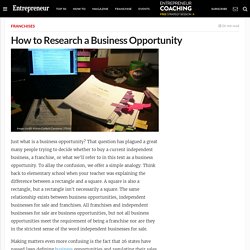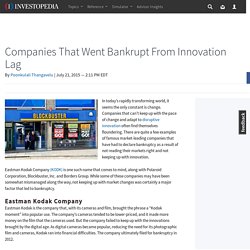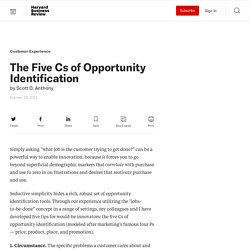

How to Research a Business Opportunity - Entrepreneur.com. Just what is a business opportunity?

That question has plagued a great many people trying to decide whether to buy a current independent business, a franchise, or what we'll refer to in this text as a business opportunity. To allay the confusion, we offer a simple analogy. Think back to elementary school when your teacher was explaining the difference between a rectangle and a square. A square is also a rectangle, but a rectangle isn't necessarily a square. The same relationship exists between business opportunities, independent businesses for sale and franchises. Making matters even more confusing is the fact that 26 states have passed laws defining business opportunities and regulating their sales. The Internet Didn't Kill Blockbuster, The Company Did It To Itself. News this week that Blockbuster will shutter its remaining 300 retail stores was greeted with the typical pithy analyses about the Internet changing everything.

They’re all wrong. Digital content distribution didn’t kill the video store. We did it to ourselves. I say “we” because I worked at Blockbuster in the mid/late 90s, so I had not only a front-row seat, but a small speaking role in the unfolding drama. The video rental business was hugely profitable from the get-go. The model was also simple, as the right titles in the right stores at the right times meant more rentals, so retailers could make even more money through improvements in distribution and inventory management. Only then the floor dropped out on Hollywood box office receipts, which had slowed by almost 2% in 1994, and barely recaptured three-fourths of that loss in 1995. With traffic down, the company elected to focus on upping the value of each transaction “basket.” Companies That Went Bankrupt From Innovation Lag. In today’s rapidly transforming world, it seems the only constant is change.

Companies that can’t keep up with the pace of change and adapt to disruptive innovation often find themselves floundering. There are quite a few examples of famous market-leading companies that have had to declare bankruptcy as a result of not reading their markets right and not keeping up with innovation. Eastman Kodak Company (KODK) is one such name that comes to mind, along with Polaroid Corporation, Blockbuster, Inc. and Borders Group. While some of these companies may have been somewhat mismanaged along the way, not keeping up with market changes was certainly a major factor that led to bankruptcy. Eastman Kodak Company Eastman Kodak is the company that, with its cameras and film, brought the phrase a “Kodak moment” into popular use.
Ironically enough, the company’s research people had actually come up with a digital camera as early as the 1970s, but the company did not see nor seize its potential. The Five Cs of Opportunity Identification. Simply asking “what job is the customer trying to get done?”

Can be a powerful way to enable innovation, because it forces you to go beyond superficial demographic markers that correlate with purchase and use to zero in on frustrations and desires that motivate purchase and use. Seductive simplicity hides a rich, robust set of opportunity identification tools. Through our experience utilizing the “jobs-to-be-done” concept in a range of settings, my colleagues and I have developed five tips for would-be innovators: the five Cs of opportunity identification (modeled after marketing’s famous four Ps — price, product, place, and promotion). 1.
Circumstance. 2. The trick is to get to context — to find a way to be with the customer when they encounter a problem and watch how they try to solve it. 3. 4. A classic example of an innovation springing from a compensating behavior is Intuit’s popular QuickBooks product. How Entrepreneurs Identify New Business Opportunities. A key question that all would-be entrepreneurs face is finding the business opportunity that is right for them.

Should the new startup focus on introducing a new product or service based on an unmet need? Should the venture select an existing product or service from one market and offer it in another where it may not be available? Or should the firm bank on a tried and tested formula that has worked elsewhere, such as a franchise operation? In the first of a series of podcasts for the Wharton-CERT Business Plan Competition, Raffi Amit, a professor of management at Wharton, discusses these questions and more with Knowledge@Wharton.
In the process, he offers insights into how entrepreneurs can identify new business opportunities and evaluate their potential and their risks. An edited transcript of the conversation appears below: Knowledge@Wharton: Our guest today is Raffi Amit, professor of Management at Wharton. Amit: My pleasure. Amit: Sure. Other companies have found similar models.